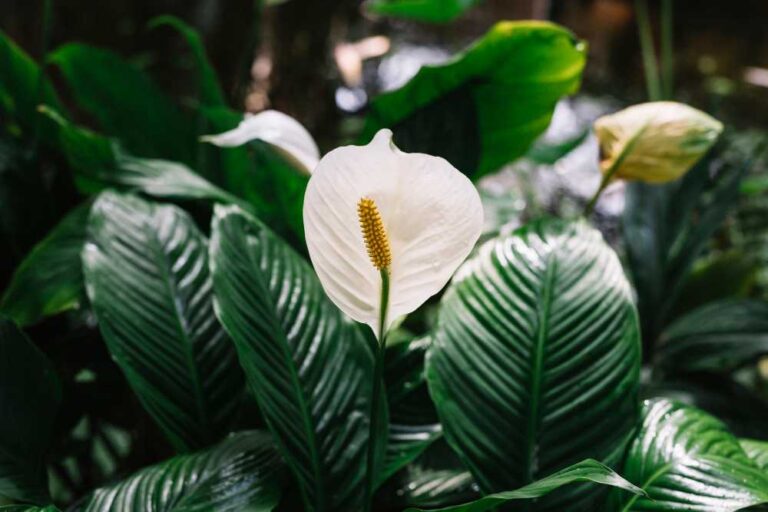Comprehensive Guide to Cultivating and Nurturing the Philodendron Ring of Fire
The Philodendron Ring of Fire Variegated, scientifically known as Philodendron bipennifolium ‘Ring of Fire,’ is a captivating and highly sought-after plant that stands out for its stunning foliage. This unique variety of philodendron is beloved for its eye-catching variegation, which adds a touch of exotic beauty to any indoor space. Below is a detailed guide covering everything you need to know about growing and caring for the Philodendron Ring of Fire:
1. Understanding the Philodendron Ring of Fire
Before diving into the care routine, it’s important to familiarize yourself with the Philodendron Ring of Fire. This plant, scientifically known as Philodendron bipennifolium ‘Ring of Fire,’ is a member of the Araceae family. What sets the Philodendron Ring of Fire Variegated apart is its striking leaf coloration. The deep green leaves are adorned with fiery red variegation that follows the edges and veins of the leaves. This captivating contrast between the rich green background and the vibrant red hues creates a mesmerizing visual display.
The variegation patterns can vary from leaf to leaf, adding an element of uniqueness to each plant. The leaves are pinnately compound, meaning they have multiple leaflets arranged on either side of the central stem. The red variegation appears along the edges and veins of the leaves, creating a captivating contrast against the green background.
2. Optimal Growing Conditions for The Philodendron Ring of Fire
Creating the right environment for your Philodendron Ring of Fire is essential for its growth and overall health. Here’s an overview of the Philodendron ring of fire care requirements to consider:
- Light: This plant thrives in bright, indirect light. While it can tolerate some morning or evening sun, direct sunlight should be avoided, as it can scorch the leaves and cause damage. Place your Ring of Fire near a north- or east-facing window with filtered light or in a spot with dappled sunlight. The plant may need more light if the leaves lose their vibrant hues or turn pale.
- Temperature: The ideal temperature range for the Philodendron Ring of Fire is between 65°F to 80°F (18°C to 27°C). Avoid exposing it to sudden temperature drops or drafts, as this can lead to stress and leaf damage.
- Humidity: It appreciates moderate to high humidity levels, so consider using a humidity tray or placing a humidifier nearby, especially in dry indoor environments. Aim for a humidity level of 50% or higher to mimic the plant’s natural tropical environment. Regular misting or using a humidity tray can help achieve this.
- Soil and Potting: Plant the Philodendron Ring of Fire in a well-draining soil mix that retains moisture without becoming waterlogged. A mix of peat, perlite, and orchid bark can work well. This soil type allows excess water to drain away, preventing root rot. Choose a pot with drainage holes that will prevent overwatering and root rot.
3. Proper Watering and Fertilizing
Achieving the right balance between watering and fertilizing is crucial for the health of your Philodendron Ring of Fire.
- Watering:
Allow the top inch or two of the soil to dry out before watering. Stick your finger into the soil to gauge moisture levels. Water thoroughly when the soil feels slightly dry to the touch, but avoid letting the plant sit in standing water. Overwatering can lead to root rot, so it’s better to underwater than overwater.
- Feeding:
During the growing season, from spring to early fall, feed your Philodendron Ring of Fire with a balanced liquid fertilizer every 4-6 weeks. Dilute the fertilizer to half the recommended strength to prevent overfeeding.
Water your plant thoroughly before applying fertilizer. This helps prevent root burn by ensuring the roots aren’t in direct contact with concentrated nutrients. After watering, apply the diluted fertilizer to the soil according to the product’s instructions. You can use a watering can or a spray bottle to distribute the fertilizer evenly. In the dormant season, reduce feeding frequency or pause altogether.
Use a balanced, water-soluble fertilizer with a ratio of 20-20-20 or 10-10-10. Additionally, you can opt for a specialized houseplant fertilizer to provide essential nutrients.
If you prefer using organic fertilizers, you can opt for slow-release granular fertilizers or create your own compost tea. Organic fertilizers release nutrients gradually over time, providing a more sustainable source of nutrition.
4. Pruning and Maintenance
Regular maintenance ensures the Philodendron Ring of Fire remains healthy and visually appealing.
- Pruning: Prune the plant to remove any dead or yellowing leaves. This not only enhances the plant’s appearance but also promotes new growth. You can trim back unruly stems to control the size or shape.
- Support: As the Ring of Fire grows, it may benefit from some support. Consider using stakes or trellises to help the plant climb and display its stunning foliage more effectively. Guide the growth of your Philodendron Ring of Fire by gently training its vines along a trellis or support. This helps maintain an attractive and well-structured appearance.
- Repotting: Repot your Philodendron Ring of Fire when you notice that the roots are becoming crowded and pot-bound. This is usually necessary every 1-2 years, and it’s best done in the spring when the plant is actively growing. Choose a slightly larger pot and fresh potting mix to provide more room for growth.
5. Propagation Techniques
If you’re looking to expand your collection of Philodendron Ring of Fire plants or share this beauty with friends, propagation is a rewarding option. Philodendron Ring of Fire plants can be propagated through the water and soil methods, offering flexibility for different preferences and conditions. Here’s a closer look at these two propagation techniques:
Water Propagation:
Water propagation involves placing a cutting in water, allowing it to develop roots before transplanting it into the soil. Here’s how to water propagate your Philodendron Ring of Fire:
- Select a Cutting: Choose a healthy stem cutting with at least one leaf node. The leaf node is where roots will develop.
- Place in Water: Submerge the lower part of the cutting with the leaf node in a water container. Make sure the leaf node is fully submerged while the upper leaves remain above water.
- Light and Location: Place the container in a location with bright, indirect light. Avoid direct sunlight, as it can be too harsh for the cutting.
- Root Development: Over the next few weeks to months, the cutting will develop roots in the water. Change the water every few days to prevent stagnation and bacterial growth.
- Transplant: Once the cutting has developed a healthy root system, carefully transplant it into a pot with a well-draining potting mix. Plant it at the same depth as in the water, burying the leaf node.
Soil Propagation:
Soil propagation involves directly planting the cutting into soil, allowing it to root and establish itself. Here’s how to soil propagate your Philodendron Ring of Fire:
- Select a Cutting: Choose a healthy stem cutting with at least one leaf node. Remove any lower leaves to expose the node.
- Prepare Potting Mix: Use a good drained potting mix that retains some moisture without being waterlogged. A mix of peat, perlite, and orchid bark can work well.
- Plant the Cutting: Make a small hole in the potting mix using a pencil or your finger. Insert the cutting into the hole, burying the leaf node and ensuring it is in contact with the soil.
- Water and Humidity: Water the soil lightly to settle it around the cutting. Place a plastic bag or clear dome over the cutting to create a humid microclimate.
- Root Development: Keep the cutting in a bright, indirect light location. Mist the cutting and the inside of the plastic cover regularly to maintain humidity.
- Transplant: Once the cutting has developed a healthy root system and you see new growth emerging, you can remove the plastic cover and continue to care for the plant as you would for a mature Philodendron Ring of Fire.
Both water and soil propagation methods have their advantages and challenges. Water propagation allows you to monitor root development more easily, while soil propagation provides a smoother transition to soil conditions. Rooting can take some time, and it’s important to provide the right care to ensure the success of the propagated cutting. With proper attention and care, you can successfully propagate your Philodendron Ring of Fire and enjoy the satisfaction of nurturing new plants from your existing ones.
6. Pest and Disease Management of The Philodendron Ring of Fire
Like many indoor plants, the Philodendron Ring of Fire can be susceptible to pests. Regularly inspect your Philodendron Ring of Fire plants for signs of infestation so you can take prompt action. Common pests that might affect this plant include:
- Mealybugs (Pseudococcidae): These small, soft-bodied insects are often found in clusters on the undersides of leaves, along stems, and in leaf axils. They can cause damage by sucking sap from the ring of fire philodendron plant, leading to yellowing leaves and stunted growth.
- Aphids (Aphidoidea): Aphids are small, soft-bodied insects that come in various colors, including green, black, brown, and pink. They typically cluster on new growth, young leaves, and stems, sucking out plant juices and secreting a sticky substance known as honeydew. This can attract other pests like ants and cause fungal growth.
- Spider Mites (Tetranychidae): Spider mites are tiny arachnids that are difficult to see with the naked eye. They often infest the leaf underside by feeding on plant cells, leading to stippling and discoloration. You might notice fine webbing between leaves and on the plant’s surface.
- Scale Insects (Coccoidea): Scales are small, immobile insects that attach themselves to plant surfaces, feeding on plant sap. They can appear as small, round, or oval bumps on stems and leaves. Some scales are hard and shell-like, while others are soft and waxy.
Regularly inspect the leaves, stems, and undersides of leaves for signs of pests such as tiny webs, sticky residue, or visible insects. If you notice minor infestations, use a damp cloth to gently wipe the pests from the leaves, or consider using insecticidal soap or neem oil.
Diseases
Like any other houseplants, Philodendron Ring of Fire plants can be susceptible to certain diseases. Here are four of the most common diseases that can afflict your Philodendron Ring of Fire:
- Root Rot (Various Fungi): Root rot is a fungal disease that occurs when the plant’s roots are consistently exposed to overly wet conditions. The roots become waterlogged, leading to rot and eventual death. Symptoms include stunted growth, wilting and yellowing leaves. To prevent root rot, ensure your plant is in well-draining soil and that you’re not overwatering.
- Leaf Spot (Various Fungi and Bacteria): Leaf spot is characterized by small, brown, or black lesions on the plant leaves. These spots may have yellow halos around them. Various fungi and bacteria can cause leaf spots. Factors contributing to leaf spots include overhead watering, high humidity, and poor air circulation. Removing and disposing of the infected leaves can help prevent the leaf spots from spreading.
- Bacterial Blight (Xanthomonas campestris): Bacterial blight is a bacterial disease that causes dark, water-soaked lesions on leaves, stems, and sometimes flowers. The lesions may turn necrotic and spread as the disease advances. Avoid overhead watering, as moisture on the leaves can encourage the spread of this disease. Prune and dispose of infected parts, and consider using copper-based sprays to control the bacteria.
- Powdery Mildew (Erysiphe cichoracearum and others): Powdery mildew appears as a white, powdery substance on the leaves, stems, and other plant parts. It can lead to distorted growth and weakened plants. This fungal disease thrives in high humidity and low air circulation conditions. To maintain good air circulation and prevent powdery mildew, around your plants and avoid overcrowding. If detected, you can use fungicidal sprays labeled for powdery mildew control.
Being aware of these common diseases and their symptoms can help you take preventive measures and address any issues promptly.
7. Dealing with Variegation Changes
The striking variegation of the Philodendron Ring of Fire can sometimes change due to environmental factors or growth habits. While the vibrant red variegation is a highlight of this plant, it’s essential to understand that it may not remain consistent throughout the plant’s life. Factors like light intensity, humidity, and overall plant health can influence the appearance of variegation.
- Light: Insufficient light can cause the red variegation to fade, resulting in greener leaves. Ensure your plant gets adequate, indirect light to maintain its vibrant colors.
- Young vs. Mature Leaves: Young leaves often display more intense variegation, while philodendron ring of fire mature leaves might have less prominent red coloring. This is a natural part of the growth process and doesn’t necessarily indicate a problem.
- Pruning and Propagation: When you’re pruning your Philodendron Ring of Fire or propagating it, be aware that emerging new growth might exhibit different variegation patterns. This is another factor that can contribute to variations in appearance.
Conclusion
Successfully growing and caring for the Philodendron Ring of Fire involves not only understanding its unique characteristics and requirements but also being prepared to adapt and address any challenges that arise. By learning about propagation techniques, staying vigilant against pests, and understanding how variegation can change, you’ll be better equipped to provide your plant with the best possible care. This exotic beauty has the potential to bring years of joy and elegance to your indoor space, making the effort you put into its care well worth it.




